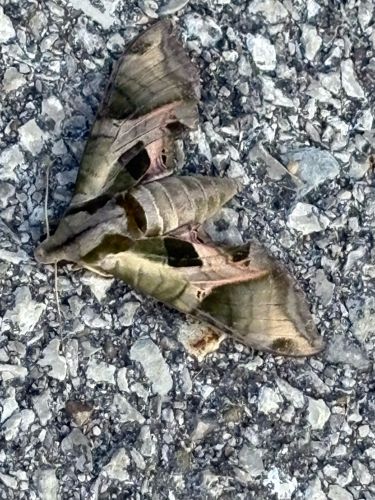Hawk-moth or Sphinx Moth (likely a species within the Hyles or Darapsa genera, e.g., Achemon Sphinx, Virginia Creeper Sphinx, or Elephant Hawk-moth if in Europe/Asia)
Scientific Name: It is difficult to determine the exact species from this image alone due to variations within the family. It appears to be a member of the Sphingidae family, possibly genus Hyles or Darapsa. Examples include *Hyles achemon* (Achemon Sphinx) or *Darapsa myron* (Virginia Creeper Sphinx), or *Deilephila elpenor* (Elephant Hawk-moth) depending on geographic location.
Order & Family: Order: Lepidoptera, Family: Sphingidae
Size: Most hawk-moths are medium to large-sized moths, with wingspans typically ranging from 4 to 15 centimeters (approximately 1.5 to 6 inches).

Natural Habitat
Hawk-moths are found in a wide variety of habitats including woodlands, gardens, meadows, and suburban areas, wherever their host plants for larval development and nectar sources for adults are present.
Diet & Feeding
Adult hawk-moths typically feed on nectar from flowers, using their long proboscis, often while hovering. Some species may not feed as adults. The larvae (caterpillars) are herbivorous, feeding on the leaves of specific host plants. For example, Achemon Sphinx caterpillars feed on grape and Virginia creeper, while Elephant Hawk-moth caterpillars feed on willowherbs and bedstraws.
Behavior Patterns
This specific moth, in its adult stage, is nocturnal or crepuscular, meaning it is active during the night or twilight hours. Its elongated wings and streamlined body suggest it is a strong and agile flier, capable of hovering. The larvae (caterpillars) are leaf feeders. The moth's coloration provides excellent camouflage against tree bark or dead leaves.
Risks & Benefits
Hawk-moths are important pollinators, especially for night-blooming flowers, contributing to ecosystem health. Their caterpillars can sometimes be considered pests if they feed on cultivated plants, but serious damage is generally rare given their relatively low populations. They pose no direct risks to humans.
Identified on: 8/22/2025